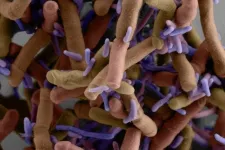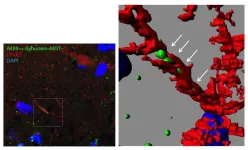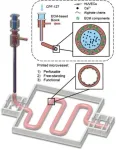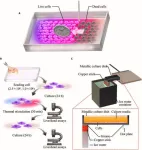(Press-News.org) CAMBRIDGE, MA -- RNA vaccines against Covid-19 have proven effective at reducing the severity of disease. However, a team of researchers at MIT is working on making them even better. By tweaking the design of the vaccines, the researchers showed that they could generate Covid-19 RNA vaccines that produce a stronger immune response, at a lower dose, in mice.
Adjuvants are molecules commonly used to increase the immune response to vaccines, but they haven’t yet been used in RNA vaccines. In this study, the MIT researchers engineered both the nanoparticles used to deliver the Covid-19 antigen, and the antigen itself, to boost the immune response, without the need for a separate adjuvant.
If further developed for use in humans, this type of RNA vaccine could help to reduce costs, reduce the dosage needed, and potentially lead to longer-lasting immunity. The researchers’ tests also showed that when delivered intranasally, the vaccine induced a strong immune response when compared to the response elicited by traditional, intramuscular vaccination.
“With intranasal vaccination, you might be able to kill Covid at the mucus membrane, before it gets into your body,” says Daniel Anderson, a professor in MIT’s Department of Chemical Engineering, a member of MIT’s Koch Institute for Integrative Cancer Research and Institute for Medical Engineering and Science (IMES), and the senior author of the study. “Intranasal vaccines may also be easier to administer to many people, since they don’t require an injection.”
The researchers believe that the effectiveness of other types of RNA vaccines that are now in development, including vaccines for cancer, could be improved by incorporating similar immune-stimulating properties.
Former MIT postdoc Bowen Li, who is now an assistant professor at the University of Toronto; graduate student Allen Jiang; and former MIT postdoc Idris Raji, who was a research fellow at Boston Children’s Hospital, are the lead authors of the new study, which appears today in Nature Biomedical Engineering. The research team also includes Robert Langer, the David H. Koch Institute Professor at MIT and a member of the Koch Institute, and several other MIT researchers.
Boosting immunity
RNA vaccines consist of a strand of RNA that encodes a viral or bacterial protein, also called an antigen. In the case of Covid-19 vaccines, this RNA codes for a segment of the virus’s spike protein. That RNA strand is packaged in a lipid nanoparticle carrier, which protects the RNA from being broken down in the body and helps it get into cells.
Once delivered into cells, the RNA is translated into proteins that the immune system can detect, generating antibodies and T cells that will recognize the protein if the person later becomes infected with the SARS-CoV-2 virus.
The original Covid-19 RNA vaccines developed by Moderna and Pfizer/BioNTech provoked strong immune responses, but the MIT team wanted to see if they could make them more effective by engineering them to have immune stimulatory properties.
In this study, the researchers employed two different strategies to boost the immune response. For the first, they focused on a protein called C3d, which is part of an arm of the immune response known as the complement system. This set of proteins helps the body fight off infection, and C3d’s role is to bind to antigens and amplify the antibody response to those antigens. For many years, scientists have been evaluating the use of C3d as a molecular adjuvant for vaccines made from proteins, such as the DPT vaccine.
“With the promise of mRNA technologies being realized with the Covid vaccines, we thought that this would be a fantastic opportunity to see if C3d might also be able to play a role as an adjuvant in mRNA vaccine systems,” Jiang says.
To that end, the researchers engineered the mRNA to encode the C3d protein fused to the antigen, so that both components are produced as one protein by cells that receive the vaccine.
In the second phase of their strategy, the researchers modified the lipid nanoparticles used to deliver the RNA vaccine, so that in addition to helping with RNA delivery, the lipids also intrinsically stimulate a stronger immune response.
To identify lipids that would work best, the researchers created a library of 480 lipid nanoparticles with different types of chemistries. All of these are “ionizable” lipids, which become positively charged when they enter acidic environments. The original Covid RNA vaccines also included some ionizable lipids because they help the nanoparticles to self-assemble with RNA and they help target cells to take up the vaccine.
“We understood that nanoparticles themselves could be immunostimulatory, but we weren't quite sure what the chemistry was that was needed to optimize that response. So instead of trying to make the perfect one, we made a library and evaluated them, and through that we identified some chemistries that seemed to improve their response,” Anderson says.
Toward intranasal vaccines
The researchers tested their new vaccine, which included both RNA-encoded C3d and a top-performing ionizable lipid identified from their library screen, in mice. They found that mice injected with this vaccine produced 10 times more antibodies than mice given unadjuvanted Covid RNA vaccines. The new vaccine also provoked a stronger response among T cells, which play important roles in combating the SARS-CoV-2 virus.
“For the first time, we’ve demonstrated a synergistic boost in immune responses by engineering both the RNA and its delivery vehicles,” Li says. “This prompted us to investigate the feasibility of administering this new RNA vaccine platform intranasally, considering the challenges presented by the mucociliary blanket barrier in the upper airways.”
When the researchers delivered the vaccine intranasally, they observed a similarly strong immune response in the mice. If developed for use in people, an intranasal vaccine could potentially offer enhanced protection against infection because it would generate an immune response within the mucosal tissues that line the nasal passages and lungs.
Because self-adjuvanting vaccines elicit a stronger response at a lower dose, this approach could also help to reduce the cost of vaccine doses, which might allow them to reach more people, especially in developing nations, the researchers say.
Anderson’s lab is now exploring whether this self-adjuvanting platform might also help boost the immune response of other types of RNA vaccines, including cancer vaccines. Working with health care companies, the researchers also plan to test the effectiveness and safety of these new vaccine formulations in larger animal models, in hopes of eventually testing them in patients.
###
The research was funded by the National Institutes of Health and Translate Bio.
END
MIT engineers design more powerful RNA vaccines
The new approach could lead to intranasal vaccines for Covid-19 and other respiratory diseases
2023-09-07
ELSE PRESS RELEASES FROM THIS DATE:
Genetic tools probe microbial dark matter
2023-09-07
Patescibacteria are a group of puzzling, tiny microbes whose manner of staying alive has been difficult to fathom. Scientists can cultivate only a few types, yet these bacteria are a diverse group found in many environments.
The few types of Patescibacteria that researchers can grow in the lab reside on the cell surfaces of another, larger host microbe. Patescibacteria in general lack the genes required to make many molecules necessary for life, such as the amino acids that make up proteins, the fatty acids that form membranes, and the nucleotides in DNA. This has led researchers ...
Revolutionizing lithium production on a string
2023-09-07
A vital component of the batteries at the heart of electric vehicles and grid energy storage, lithium is key to a clean energy future. But producing the silvery-white metal comes with significant environmental costs. Among them is the vast amount of land and time needed to extract lithium from briny water, with large operations running into the dozens of square miles and often requiring over a year to begin production.
Now, researchers at Princeton have developed an extraction technique that slashes the amount of land and time needed for lithium production. The researchers say their system ...
Genetic study of blood glucose levels calls for stratified treatment with GLP-1R agonists in type 2 diabetes, reveals the role of the intestine, and impact on lung function
2023-09-07
New research highlights that genetic background can affect individual responses to GLP-1R agonist drugs.
Researchers reveal for the first time that high blood sugar levels in type 2 diabetes can play a causal role in lung disorders.
The study sheds light on the role of the digestive system, including the small intestine, ileum, and colon, in controlling blood sugar levels.
This is the largest-ever study into the genetic basis of random "round-the-clock" blood sugar levels.
Groundbreaking research published today in Nature Genetics describes the largest-ever study into the genetics of random "round-the-clock" ...
Bursting air bubbles may play a key role in how glacier ice melts, Oregon State research suggests
2023-09-07
CORVALLIS, Ore. – Oregon State University research has uncovered a possible clue as to why glaciers that terminate at the sea are retreating at unprecedented rates: the bursting of tiny, pressurized bubbles in underwater ice.
Published today in Nature Geoscience, the study shows that glacier ice, characterized by pockets of pressurized air, melts much more quickly than the bubble-free sea ice or manufactured ice typically used to research melt rates at the ocean-ice interface of tidewater glaciers.
Tidewater glaciers are rapidly retreating, the authors say, resulting in ice mass loss in Greenland, the Antarctic Peninsula and other glacierized regions around the globe.
“We ...
A secret passage for mutant protein to invade the brain
2023-09-07
Researchers from Tokyo Medical and Dental University (TMDU) show that the protein involved in Parkinson’s disease, α-synuclein, can propagate through the lymphatic system of the brain before it aggregates
Tokyo, Japan – In many neurodegenerative disorders, abnormal proteins progressively aggregate and propagate in the brain. But what comes first, aggregation or propagation? Researchers from Japan share some new insights about the mechanism involved in Parkinson’s disease.
In a study published ...
The need to hunt small prey compelled prehistoric humans to produce appropriate hunting weapons and improve their cognitive abilities
2023-09-07
A new study from the Department of Archaeology at Tel Aviv University found that the extinction of large prey, upon which human nutrition had been based, compelled prehistoric humans to develop improved weapons for hunting small prey, thereby driving evolutionary adaptations. The study reviews the evolution of hunting weapons from wooden-tipped and stone-tipped spears, all the way to the sophisticated bow and arrow of a later era, correlating it with changes in prey size and human culture and physiology.
The researchers explain: "This study was designed to examine a broader unifying hypothesis, which we proposed in a previous paper published in ...
Bioprinting methods for fabricating in vitro tubular blood vessel models
2023-09-07
A review paper by scientists at the Chonnam National University summarized the recent research on bioprinting methods for fabricating bioengineered blood vessel models. The new review paper, published on Aug. 1 in the journal Cyborg and Bionic Systems, provided an overview on the 3D bioprinting methods for fabricating bioengineered blood vessel models and described possible advancements from tubular to vascular models.
“3D bioprinting technology provides a more precise and effective means for investigating biological processes and developing new treatments than traditional 2D cell cultures. Therefore, it is a crucial tool ...
Titanium culture vessel presenting temperature gradation for the thermotolerance estimation of cells
2023-09-07
Hyperthermia is a potentially non-invasive cancer treatment that capitalizes on the heat intolerance of cancer cells, which are more sensitive than normal cells. In order to induce effective hyperthermia, it is necessary to apply the appropriate temperature according to the cell type, i.e., to comprehensively study the thermal toxicity of the cells, which requires accurate regulation of the culture temperature. Researchers from Keio University in Japan have developed a cell culture system with temperature ...
1 in 2 patients had better blood pressure control after using remote, bilingual program
2023-09-07
Research Highlights:
More than half of adults (55%) with uncontrolled blood pressure who enrolled in a digital monitoring program that connected patients with clinical advice and included a bilingual app paired with at-home blood pressure monitors had controlled final blood pressure measurements after participating for least 90 days.
Patients using the Spanish-language version of the digital monitoring program demonstrated more improvement in blood pressure control than patients who used the English-language version.
Embargoed until 6:30a.m. CT/7:30 a.m. ET Thursday, Sept. 7, 2023
BOSTON, Sept. 7, 2023 — Over half of patients ...
High blood pressure while lying down linked to higher risk of heart health complications
2023-09-07
Research Highlights:
An analysis of data from a long-running study of more than 11,000 adults from four diverse communities in the United States has found that adults who had high blood pressure while both seated upright and lying supine (flat on their backs) had a higher risk of heart disease, stroke, heart failure or premature death compared to adults without high blood pressure while upright and supine.
Adults who had high blood pressure while lying supine but not while seated upright had similar elevated risks of heart attack, stroke, ...
LAST 30 PRESS RELEASES:
IADR elects George Belibasakis as vice-president
Expanding the search for quantum-ready 2D materials
White paper on leadership opportunities for AI to increase employee value released by University of Phoenix College of Doctoral Studies
ASH 2025: New combination approach aims to make CAR T more durable in lymphoma
‘Ready-made’ T-cell gene therapy tackles ‘incurable’ T-cell leukemia
How brain activity changes throughout the day
Australian scientists reveal new genetic risk for severe macular degeneration
GLP-1 receptor agonists likely have little or no effect on obesity-related cancer risk
Precision immunotherapy to improve sepsis outcomes
Insilico Medicine unveils winter edition of Pharma.AI, accelerating the path to pharmaceutical superintelligence
Study finds most people trust doctors more than AI but see its potential for cancer diagnosis
School reopening during COVID-19 pandemic associated with improvement in children’s mental health
Research alert: Old molecules show promise for fighting resistant strains of COVID-19 virus
Journal of Nuclear Medicine Technology supplement highlights advances in theranostics and opportunities for growth
New paper rocks earthquake science with a clever computational trick
ASH 2025: Milder chemo works for rare, aggressive lymphoma
Olfaction written in bones: New insights into the evolution of the sense of smell in mammals
Engineering simulations rewrite the timeline of the evolution of hearing in mammals
New research links health impacts related to 'forever chemicals' to billions in economic losses
Unified EEG imaging improves mapping for epilepsy surgery
$80 million in donations propels UCI MIND toward world-class center focused on dementia
Illinois research uncovers harvest and nutrient strategies to boost bioenergy profits
How did Bronze Age plague spread? A sheep might solve the mystery
Mental health professionals urged to do their own evaluations of AI-based tools
Insufficient sleep associated with decreased life expectancy
Intellicule receives NIH grant to develop biomolecular modeling software
Mount Sinai study finds childhood leukemia aggressiveness depends on timing of genetic mutation
RSS Research Award for new lidar technology for cloud research
Novel AI technique able to distinguish between progressive brain tumours and radiation necrosis, York University study finds
Why are abstinent smokers more sensitive to pain?
[Press-News.org] MIT engineers design more powerful RNA vaccinesThe new approach could lead to intranasal vaccines for Covid-19 and other respiratory diseases






